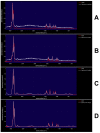Assessing the Occurrence and Distribution of Microplastics in Surface Freshwater and Wastewaters of Latvia and Lithuania
- PMID: 37112519
- PMCID: PMC10146209
- DOI: 10.3390/toxics11040292
Assessing the Occurrence and Distribution of Microplastics in Surface Freshwater and Wastewaters of Latvia and Lithuania
Abstract
Microplastic concentrations in surface water and wastewater collected from Daugavpils and Liepaja cities in Latvia, as well as Klaipeda and Siauliai cities in Lithuania, were measured in July and December 2021. Using optical microscopy, polymer composition was characterized using micro-Raman spectroscopy. The average abundance of microplastics in surface water and wastewater samples was 16.63 ± 20.29 particles/L. The dominant shape group of microplastics in water was fiber, with dominant colors found to be blue (61%), black (36%), and red (3%) in Latvia. Similar distribution in Lithuania was found, i.e., fiber (95%) and fragments (5%) with dominant colors, such as blue (53%), black (30%), red (9%), yellow (5%), and transparent (3%). The micro-Raman spectroscopy spectra of visible microplastics were identified to be polyethylene terephthalate (33%) and polyvinyl chloride (33%), nylon (12%), polyester (PS) (11%), and high-density polyethylene (11%). In the study area, municipal and hospital wastewater from catchment areas were the main reasons for the contamination of microplastics in the surface water and wastewater of Latvia and Lithuania. It is possible to reduce pollution loads by implementing measures such as raising awareness, installing more high-tech wastewater treatment plants, and reducing plastic use.
Keywords: distribution; microplastics; occurrence; surface water; wastewaters.
Conflict of interest statement
The authors declare no conflict of interest.
Figures
References
-
- Hale R.C., Seeley M.E., La Guardia M.J., Mai L., Zeng E.Y. A Global Perspective on Microplastics. J. Geophys. Rese. Oceans. 2020;125:e2018JC014719. doi: 10.1029/2018JC014719. - DOI
-
- Moyo M., Falayi T. Impact of Plastic Waste on the Marine Biota. Springer; Singapore: 2022. Generation and management of microplastic waste; pp. 3–20.
LinkOut - more resources
Full Text Sources



